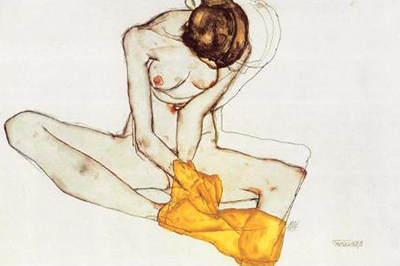Girl with Yellow Scarf is a simple but interesting artwork from Egon Schiele from the early 20th century, at a time of turmoil all across Europe.
Girl with Yellow Scarf contains all of these features that Schiele is known for, depicting the form of a slightly contorted young woman in the nude, with her hands and feet covered completely by a slightly transparent yellow scarf. The girl sits in an almost crosslegged position and looks to be possibly tied down by the scarf, which drapes below the frame of the painting. The recurring outline of the girl to the right of her frame also suggests some movement towards the left of the picture. It was created with pencil and an opaque watercolour paint, gouache, on paper. In Schiele's native language, the painting is named Mädchen Akt mit gelbem Tuch.
Egon Schiele (12 June 1890 - 31 October 1918) was born in Tulin, Lower Austria. Painted in 1913, Girl with Yellow Scarf is a classic example of Egon Schiele's watercolour work. Schiele is seen as an early exponent of Expressionism due to his style featuring expressive lines and twisted body figures. His paintings often contained an aspect of sexuality centred around the form of women. The face of the subject of the painting cannot be seen and is not specified, although many of Schiele's female portraits were of his lover Walburga (Wally) Neuzil, who modelled and was named in a number of paintings. As she is not named in Girl with Yellow Scarf, the model is likely to just be a model from the town that Schiele lived in at the time. Schiele caused controversy in 1911 - 1912 by using young models, however Girl with Yellow Scarf was created after his time in prison for seducing a woman below the age of consent.
Schiele was a highly sexual individual which can be seen precisely within portraits such as this. He also overlapped between using models and having relationships with them, which quickly started to court controversy with parents of some of his muses. He became untrusted by many, particularly when working within smaller communities and it became clear that Vienna might be the only location in which he could work freely. His preference seemed to be for slim young women, in their late teens, often with light hair, similar to his sister. His later wife would also fit this picture fairly accurately although it would have been a fairly common aesthetic within Austria at that time in any case. Within this artwork the scarf is most likely added in order to allow a flush of colour to make its way into the painting, as his nude portraits would normally be portrayed in fairly light and neutral tones that did not contrast too much with the plain backgrounds behind.




